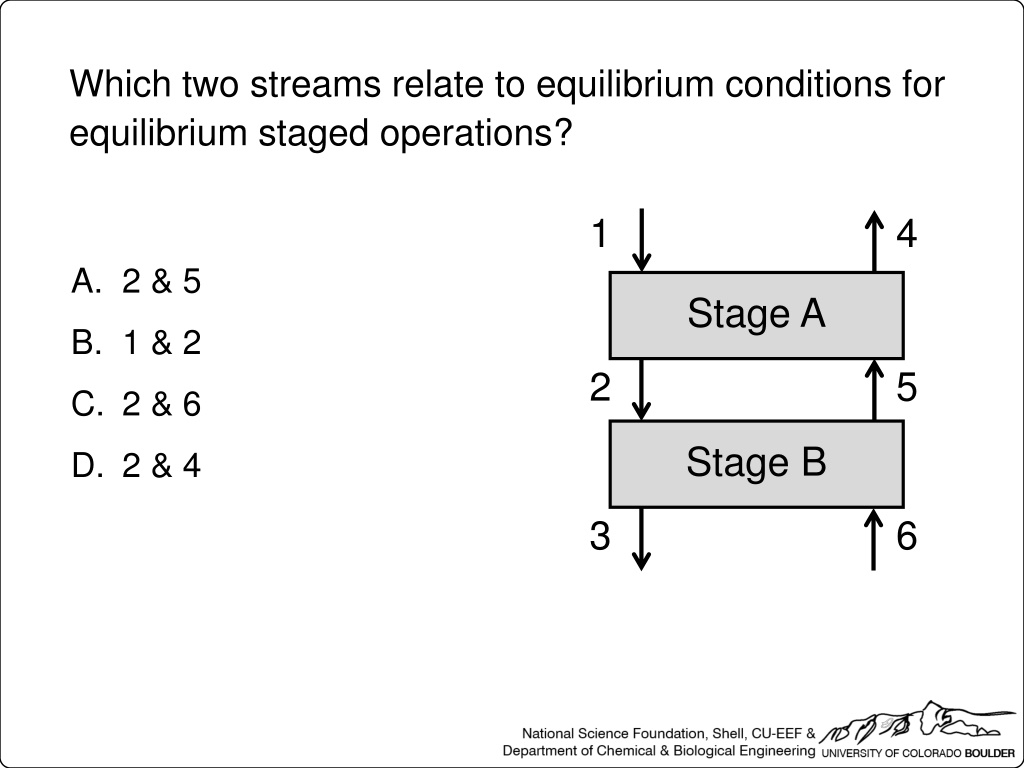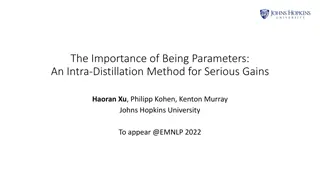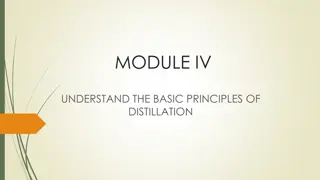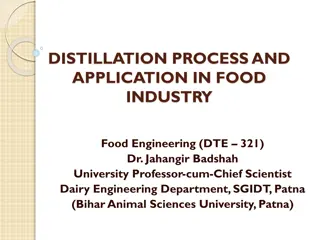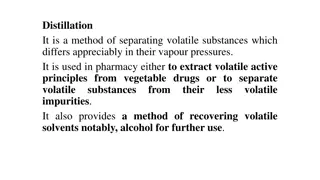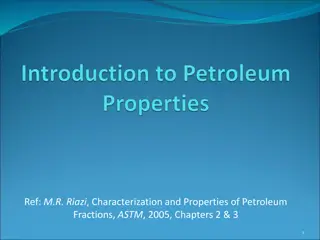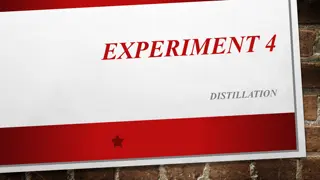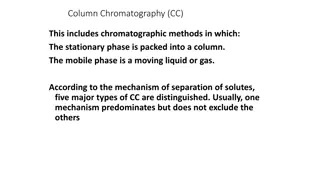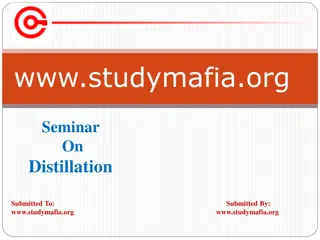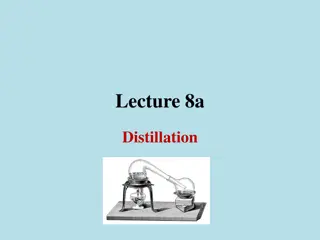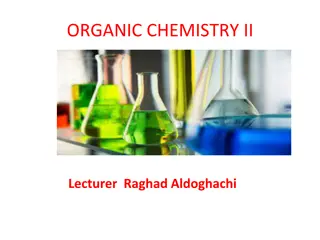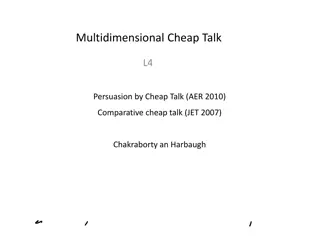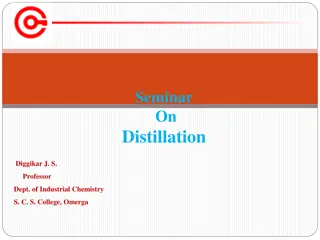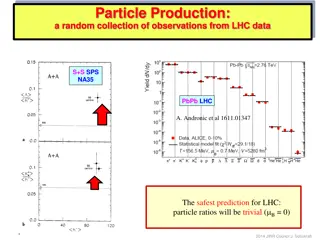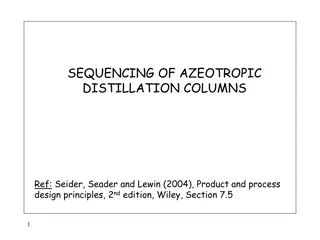Distillation Column Operations and Equilibrium Conditions
Explore various aspects of distillation column operations, including equilibrium and operating conditions, total condenser setups, feed stage mass/energy balances, McCabe-Thiele solutions, and limiting operating conditions. Learn about vapor/liquid efficiencies and the relationships between different streams in distillation processes.
- Distillation Column
- Equilibrium Conditions
- Operating Conditions
- Total Condenser
- McCabe-Thiele
- Vapor/Liquid Efficiencies
Download Presentation

Please find below an Image/Link to download the presentation.
The content on the website is provided AS IS for your information and personal use only. It may not be sold, licensed, or shared on other websites without obtaining consent from the author. Download presentation by click this link. If you encounter any issues during the download, it is possible that the publisher has removed the file from their server.
E N D
Presentation Transcript
Which two streams relate to equilibrium conditions for equilibrium staged operations? 1 4 A. 2 & 5 Stage A B. 1 & 2 2 5 C. 2 & 6 Stage B D. 2 & 4 3 6
Which two streams relate to operating conditions for equilibrium staged operations? 1 4 A. 2 & 5 Stage A B. 1 & 2 2 5 C. 2 & 6 Stage B D. 2 & 4 3 6
Total condenser Which of the following relationships is true using the distillation setup shown? K = thermodynamic K-value yN xN+1 N xN yN 1 N-1 A. y2= K2x1 B. x2= K1x1 C. y1= K1x2 D. x1= K1y1 2 1 y1 x2 y0 x1 Total reboiler
Consider the mass/energy balance envelope constructed around the feed stage of a distillation column. As the feed quality increases, the molar flow rate of the liquid stream L _________. V L A. increases B. decreases F, q C. remains the same V L
A McCabe-Thiele solution to a distillation column separating methanol and water is shown. The blue line is the top operating line and the green line is the bottom operating line. Which stage is the feed stage? 1 1 2 0.8 3 0.6 A. 1 yMethanol B. 2 0.4 B C. 3 0.2 D. partial reboiler (B) 0 0 0.2 0.4 xMethanol 0.6 0.8 1
A McCabe-Thiele solution to a distillation column separating methanol and water is shown. Currently, the feed stage is number _______, but the optimum feed stage is number ________. 1 1 2 C 0.8 A. 4, 3 3 0.6 B. 3, 3 yMethanol 4 C. 3, 1 0.4 D. 3, Boiler 0.2 B E. 4, 4 0 0 0.2 0.4 0.6 0.8 1 xMethanol
In column distillation, the limiting operating conditions of minimum reflux and total reflux represent a(n) _________ and a(n) __________ number of stages for a given separation, respectively. A. minimum, maximum B. infinite, minimum C. infinite, maximum D. maximum, minimum
Murphree vapor/liquid efficiencies can exceed one and be less than zero. A. true B. false
For a binary distillation column operating at atmospheric pressure, the temperature __________ from the bottom to the top of the column. A. increases B. decreases C. is constant D. depends on the separation
For a binary distillation column operating at constant temperature, the pressure __________ from the bottom to the top of the column. A. increases B. decreases C. is constant D. depends on the separation
An operator is creating a dial to control the reflux ratio in a distillation column. What must be the two values for the limits of the dial? V A. -1 and 1 B. 0 and 1 C. 1 and L D D. 0 and Dial
Which of the following plots cannot be used to represent a rectifying section operating line for a distillation column separating a binary mixture? Plots are for more volatile species. Vapor mol fraction 0 Vapor mol fraction Vapor mol fraction A. 3, 4, 6 1 2 3 B. 4 & 5 0 0 C. 4, 5, 6 Liquid mol fraction Liquid mol fraction Liquid mol fraction D. 1 & 2 Vapor mol fraction Vapor mol fraction Vapor mol fraction E. 3, 4, 5, 6 4 5 6 0 0 0 Liquid mol fraction Liquid mol fraction Liquid mol fraction
Which of the following plots cannot be used to represent a stripping section for a distillation column separating a binary mixture? Vapor mol fraction Vapor mol fraction Vapor mol fraction A. 2 B. 1, 2, 3 1 2 3 C. 2, 3, 5 0 0 0 Liquid mol fraction Liquid mol fraction Liquid mol fraction D. 2, 5 Vapor mol fraction Vapor mol fraction Vapor mol fraction E. All but 4 4 5 6 0 0 0 Liquid mol fraction Liquid mol fraction Liquid mol fraction
Which of the following tray holes prevents weeping at low vapor flow (or start up of vapor flow)? 1 2 A. tray 1 B. tray 2 C. both trays D. neither trays
A distillation column has 8 stages, a total condenser and a partial reboiler. What is the liquid mole fraction of the more volatile component entering stage 8? 1 0.9 0.8 Vapor mole fraction (y) 0.7 A. 0.04 0.6 B. 0.10 0.5 0.4 C. 0.24 0.3 D. 0.80 0.2 XY diagram for more volatile component 0.1 0 0 0.1 0.2 0.3 0.4 0.5 0.6 0.7 0.8 0.9 1 Liquid mole fraction (X)
A distillation column has 8 stages, a partial condenser and a total reboiler. What is the liquid mole fraction of the more volatile component entering stage 8? 1 0.9 0.8 Vapor mole fraction (y) A. 0.04 0.7 0.6 B. 0.10 0.5 C. 0.24 0.4 D. 0.80 0.3 0.2 XY diagram for more volatile component 0.1 0 0 0.1 0.2 0.3 0.4 0.5 0.6 0.7 0.8 0.9 1 Liquid mole fraction (X)
What is the efficiency of a column that we has a partial condenser, a partial reboiler, and 6 physical trays in the column? 1 0.9 0.8 Vapor mole fraction (y) A. 67% 0.7 0.6 B. 50% 0.5 C. 33% 0.4 0.3 D. 16% 0.2 XY diagram for more volatile component 0.1 0 0 0.1 0.2 0.3 0.4 Liquid mole fraction (X) 0.5 0.6 0.7 0.8 0.9 1
What is the optimal feed location (tray #) for a column with a partial condenser, a partial reboiler and 33% tray efficiency if the feed is saturated liquid at zF = 0.62? 1 0.9 0.8 A. 1 Vapor mole fraction (y) 0.7 B. 2 0.6 0.5 C. 3 0.4 D. 4 0.3 0.2 XY diagram for more volatile component E. 5 0.1 0 0 0.1 0.2 0.3 0.4 Liquid mole fraction (X) 0.5 0.6 0.7 0.8 0.9 1
Which feed condition minimizes the difference between partial reboiler and total condenser duties for an ideal binary separation in a distillation column? A. supercooled liquid B. saturated liquid C. saturated vapor D. superheated vapor
Which of the following material balance relationships are true for a binary distillation column operating with a saturated liquid feed, a total condenser and partial reboiler? (R = reflux ratio = L/D) V L D A. L = D - F F B. L = R*D C. L = R*D + F V D. L = R*D + F - B B L
A distillation column operates with a saturated liquid feed, F1, and a reflux ratio of 2. If another saturated liquid stream is fed at a lower stage (F2), how does the slope of the rectifying operating line change? R = 2 A. decreases F1 B. increases C. remains the same F2 D. depends on quality of F2
A distillation column with a total condenser and partial reboiler separates a binary mixture. Lowering the reflux ratio decreases the tray efficiency. The number of trays needed to achieve the same separation as before ________. A. increases B. decreases C. remains the same D. depends on reflux ratio
When performing separation under vacuum in a column distillation, a _______ column should be used since the pressure drop across this column is lower. A. packed B. trayed C. negligible difference packed trayed
Which is most likely true for a liquid passing along a tray in a column distillation for short residence times and uneven mixing? x is the mole fraction of the more volatile component. A. xout> x1 B. xout< x1 C. xout= x1
Which of the following results in only vapor products (D and B)? 1) Partial condenser 3) Partial reboiler 5) Total reflux 2) Total condenser 4) Total reboiler 6) Total boilup V A. 1 & 3 L D B. 5 & 6 F Note: not drawn for all setups C. 2 & 4 V D. 2 & 6 E. 4 & 5 B L
The McCabe-Thiele solution is shown for a distillation column with a saturated liquid sidestream (S) product. Keeping reflux constant, what happens to the number of stages needed in the rectifying section if the flow rate of S increases? 1 0.9 A. increases 0.8 0.7 B. decreases 0.6 Y MEOH 0.5 C. no change 0.4 0.3 0.2 0.1 0 0 0.1 0.2 0.3 0.4 0.5 0.6 0.7 0.8 0.9 1 X MEOH
Which of the following ideal binary distillation columns uses the most energy? Feed conditions, pressure, reflux ratio, and top and bottoms compositions are constant. A B C D. No difference
For the following distillation system, which of the following component pairs are designated as the light key (LK) and heavy key (HK)? (Note: Components are in order of volatility, = signifies a double bond) C3= 2.5 kmol/h A. C1 and C2= B. C1 and nC4 C. C2 and C3= D. C2= and C2 Distillation kmol/h C1 C2= C2 C3= C3 nC4 500 1,250 1,000 100 50 25 C2 0.5 kmol/h
Compound R and compound S are separated in a batch distillation process. Given that PRsat < Pssat and the solution is ideal, the first drop of distillate will be enriched in ____________. A. compound R B. compound S xR, xS C. depends on the initial mole fractions Q
Compound R and compound S are separated by batch distillation. Given PRsat < Pssat and the solution is ideal, the mole fraction of S in the distillate _________ as the process proceeds. xR, xS A. increases B. decreases C. depends on initial mole fractions Q
Compound R and compound S are separated through batch distillation. Given PRsat < Pssat and the solution is ideal, the mole fraction of S in the feed-stock _________ as time proceeds. xR, xS A. increases B. decreases C. depends on initial mole fractions Q
A 100-mol mixture of benzene and toluene are fed into a batch distillation still, which is heated to keep the boil-up rate constant. Which of the following does not change during the distillation? A. distillate composition B. bottoms composition C. still temperature D. distillate flow rate E. none of the above
The amount of vapor product produced in a flash distillation process is dependent on _________. A. the feed composition B. the temperature of the flash operation C. the temperature of the feed D. A & B E. All of the above
Given a feed of 40 mol% EtOH, what is the maximum ethanol vapor fraction achievable in a flash drum? A. 0.08 B. 0.40 C. 0.55 D. 0.62
For a flash distillation at its bubble point, what fraction (V/F) of a feed stream becomes vapor? A. V/F 0, all liquid B. V/F 1, all vapor C. Cannot determine
If three flash tanks were stacked, how would the pressures of each tank be set to maximize separation efficiency? V1 liquid P1 A. P1 > P2 > P3 B. P1 > P3 > P2 C. P1 < P2 < P3 D. P1 < P3 < P2 V2 L1 liquid P2 L2 V3 liquid feed P3 L3
A liquid feed containing 20 mol% MeOH enters a flash tank at 3 psia. If we compress the exiting vapor to 6 psia then send it to another tank operating at 4 psia, what is the vapor mole fraction of MeOH leaving the 2nd tank? A. 0.1 B. 0.2 C. 0.4 D. 0.6 E. 0.99
What will happen if we recycle the liquid stream from tank 2 (L2) back to tank 2? (y is the mole fraction of the more volatile component in the vapor) V1 liquid P1 A. y2 decreases B. y2 increases C. Ratio of L/V produced from tank 2 increases V2 L1 liquid P2 L2 V3 D. Ratio of L/V produced from tank 2 decreases liquid feed P3 E. A & C L3
How should the temperature for each stage be set for stacked flash tanks under isobaric conditions? A. T1 > T2 > T3 > T4 > T5 B. T1 < T2 < T3 < T4 < T5 C. T1 < T2 < T3 > T4 < T5
Which vapor flow rate is larger, V1 or V2? A. V1 B. V2 C. V1 = V2
